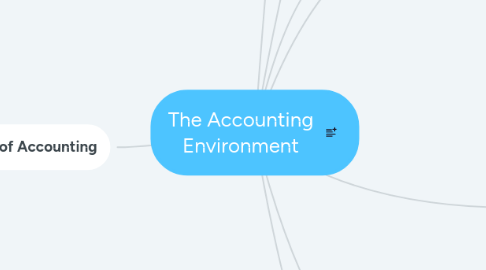
1. Nature and Role of Accounting
1.1. An information system
1.2. Communication of financial information
1.3. to users
1.3.1. inside and outside of the enity
1.4. For making economic decisions
1.4.1. Allocation of scare resources
1.5. Users of Accounting Information
1.5.1. Internal focus
1.5.1.1. Planning
1.5.1.2. Organising
1.5.1.3. Directing
1.5.1.4. Controlling
1.5.1.5. Decision-making
1.5.1.6. Cost behaviour
1.5.1.7. Budgeting Reports ondemand
1.5.2. External focus (shareholders/stakeholders)
1.5.2.1. Reporting information
1.5.2.2. Performance (Income
1.5.2.3. statement)
1.5.2.4. Position (Balance Sheet)
1.5.2.5. Financing and investing
1.5.2.6. Compliance
1.5.2.7. Reports at regular
1.5.2.8. intervals
1.5.2.9. Reports
1.5.2.9.1. Overall performance
1.5.2.9.2. Financial position
1.5.2.9.3. Financing and investing activities
1.5.2.9.4. Compliance with the law
1.6. Diverse Roles of Accountants
1.6.1. Public Accounting
1.6.1.1. Provide their professional services to the public and work in a range of offices from small to multi-national
1.6.1.2. Audit, Taxation, Advisory Services
1.6.2. Commercial Accounting
1.6.2.1. Work in industry and commerce
1.6.2.2. Management Accounting
1.6.2.3. Chief Financial Officer
1.6.3. Government Accounting
1.6.3.1. Variety of roles such as financial accounting and auditing
1.6.3.2. Federal, State, Local Government
1.6.4. Not-For-Profit Accounting
1.6.4.1. Work in the not-for-profit sector
1.6.4.2. Engage in planning, decision making, preparing financial and management reports for both internal and external users
1.7. Professional Ethics
1.7.1. 1990s – attention on ethics in business
1.7.1.1. – Media
1.7.1.2. – Professional associations
1.7.1.3. – Regulatory bodies
1.7.2. Early 2000s – collapse of several large businesses
1.7.2.1. -> increased pressure from community
1.7.3. Ethics in Business
1.7.3.1. Honest
1.7.3.2. Abide by rules
1.7.3.3. “Do the right thing”
1.7.3.4. 1) Financial statements
1.7.3.4.1. Accountability of managers for resources of organization
1.7.3.4.2. Protect interests of parties that are concerned with business’ performance
1.7.3.5. 2) Audits
1.7.3.5.1. Independent auditors provide an opinion as to whether the financial statements
1.7.4. Ethics and Professional Accounting Bodies
1.7.4.1. IFAC Code of Ethics for Professional Accountants
1.7.4.2. APESB (Accounting Professional and Ethical Standards Board) set minimum standards
1.7.4.3. APES 110
1.7.5. What Ethical Behavior is expected of Accountants?
1.7.5.1. Integrity
1.7.5.2. Objectivity
1.7.5.3. Professional competence and due care
1.7.5.4. Confidentiality
1.7.5.5. Professional behaviour
1.7.6. Professional Conduct
1.7.6.1. Competence
1.7.6.2. Conformity with law
1.7.6.3. Accounting standards
1.7.6.4. Auditing and assurance standards
1.7.6.5. Confidentiality of client information
1.7.6.6. Independence
2. Dynamic Environment of Accounting
2.1. Development of information and communications technology
2.2. Demand by society for non-financial information
2.2.1. Occupational health and safety
2.2.2. Employment equity
2.2.3. Pollution and environmental sustainability
2.3. Globalization - local and worldwide markets
2.4. Global regulations - International Financial Reporting Standards (IFRS)
3. Economic Decisions
3.1. Decisions Making
3.1.1. Using information in Economic Decisions
3.1.1.1. Accounting information is used by those inside and outside of the business
3.1.1.1.1. Past performance
3.1.1.1.2. Current performance
3.1.1.1.3. Projected future information
3.1.2. 1. Establish goals
3.1.3. 2. Gather information
3.1.4. 3. Determine the consequences of alternatives
3.1.5. 4. Choose a course of action
3.2. Involve resources traded in the market place becuase they are scare
3.2.1. Consumption
3.2.2. Investment
3.2.3. Financial
3.3. Involve flow of money
4. Evaluate outcomes
4.1. New Decisions
5. What is Accounting?
5.1. To provide and interpret financial information useful for making decisions
5.2. Measure the outcomes and consequences of decisions
6. The Accounting Process
6.1. Identifying
6.1.1. Measuring
6.1.1.1. Recording
6.1.1.1.1. Communication
6.1.1.1.2. Analysing, recording, classifying and summarising transactions
6.1.1.2. Quantifying in monetary terms
6.1.2. Taking into consideration all transaction which affect business entity
7. Nature of accounting
7.1. Language of business
7.1.1. Flow of information from one person to another
7.1.2. Receiver must understand the message
7.1.3. Special worlds and symbols
